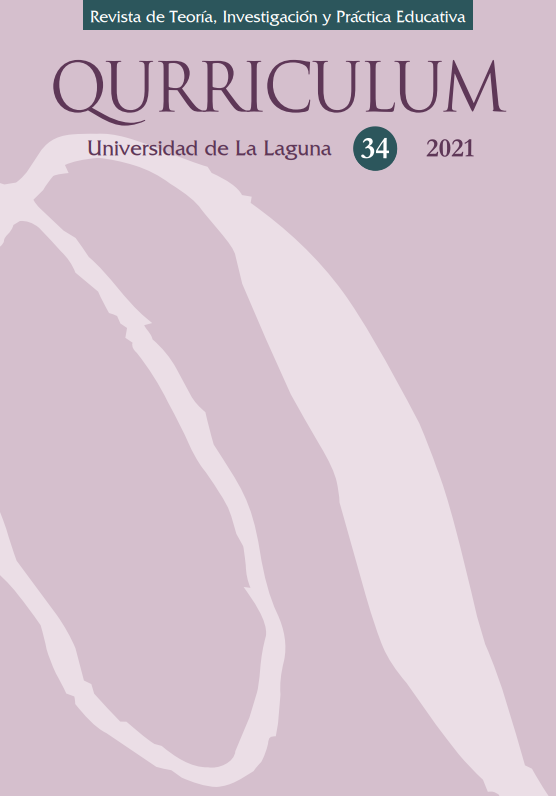Flipped Classroom: una experiencia con estudiantes universitarios
Resumen
Este trabajo desarrolla una experiencia basada en el sistema Flipped Classroom con 110 estudiantes de grado universitario. Se han recogido sus opiniones, percepciones y valoración sobre su satisfacción con este método, en comparación con el sistema tradicional. La idea central es contribuir a conocer cuáles son los resultados de la aplicación de un modelo de Aula Invertida en algunas asignaturas universitarias, de forma que se puedan recoger datos sobre las percepciones y opiniones de los principales protagonistas del aprendizaje: el alumnado. Esto se encuadra bajo un marco de mejora continua que permita a los estudiantes valorar una propuesta de AI respecto de lo que hasta ahora conocen y se puede denominar como enseñanza tradicional
Citas
Abeysekera, L. y Dawson, P. (2015). «Motivation and cognitive load in the flipped classroom: definition, rationale and a call for research». Higher Education Research & Development, 34 (1), 1-14. doi: https://doi.org/10.1080/07294360.2014.934336.
Angelini, M.L. y García-Carbonell, A. (2015). «Percepciones sobre la integración de modelos pedagógicos en la formación del profesorado: la simulación y juego y el Flipped Classroom». EKS, 16 (2), 16-30. doi: http://dx.doi.org/10.14201/eks20151621630.
Arnold-Garza, S. (2014). «The fliped Classroom teaching model and its use for information literacy instruction». Communications in Information Literacy, 8 (1), 7-22.
Bergmann, J. y Sams, A. (2012). Flip your classroom: Reach every student in every class every day. Washington, DC. Internal Society for Technology in Education.
Cole, J.E. y Kritzer, J.B. (2009). «Strategies for Success: Teaching an Online Course». Rural Special Education Quarterly, 28 (4), 36-40. Recuperado de https://journals.sagepub.com/doi/pdf/10.1177/875687050902800406.
Cukurbasi, B. y Kiyici, M. (2018). «High School Students’ Views on the PBL Activities Supported via Flipped Classroom and LEGO Practices». Educational Technology & Society, 21 (2), 46-61.
Estes, M.D., Ingram, R. y Liu, J.C. (2014). «A review of Flipped Classroom research, practice, and technologies». International HETL Review 4(7). Recuperado de https://www.hetl.org/feature-articles/a-review-ofFlipped-classroom-research practice-and-technologies.
Gannod, G.C., Burge, J.E. y Helmick, M.T. (2008). Proceedings of the 30th International Conference on Software Engineering: Using the inverted classroom to teach software engineering. New York, NY: ACM.
García-Gil, D. y Cremades-Andreu, R. (2019). Flipped Classroom en educación superior. Un estudio a través de relatos de alumnos». RMIE, 24 (80), 101-123.
González Zamar, M.D. y Abad Segura, E. (2020). «Flipped Classroom: a challenge to university education. Virtualidad Educación y Ciencia, 11 (20), 75-91.
Jovanovic, J., Gasevic, D., Dawson, S., Pardo, A. y Mirriahi, N. (2017). «Learning nalytics to inveik learning strategies in a flipped classroom». Internet and Higher Education, 33, 74-85. doi: https://doi.org/http://dx.doi.org/10.1016/j.iheduc.2017.02.001.
Lage, M.J., Platt, G.J. y Treglia, M. (2000). «Inverting the Classroom: A Gateway to Creating an Inclusive Learning Environment». The Journal of Economic Education, 31 (1), 30-43. doi: https://doi.org/10.1080/00220480009596759.
Lakmal, A. y Dawson, P. (2015). «Motivation and cognitive load in the Flipped Classroom: definition, rationale and a call for research». Higher Education Research and Development, 34(1), 1-14.
Lewin, D.R. y Barzilai, A. (2017). «Flipping the Capstone Process Design Course». Computer Aided Chemical Engineering, 40, 2923-2928. Elsevier Masson SAS. doi: https://doi.org/10.1016/B978-0-444-63965-3.50489-X.
Mason, G.S., Shuman, T.R. y Cook, K.E. (2013). «Comparing the effectiveness of an inverted classroom to a traditional classroom in an upper-division engineering course». IEEE Transactions on Education, 56(4), 430-435. doi: https://doi.org/10.1109/TE.2013.2249066.
Min-Kyung, L. (2018). «Flipped Classroom as an alternative future class model?: implications of South Korea´s social experiment». Education Tech Research Dev, 66, 837-857.
Overmyer, J. (2012, September). Flipped classrooms 101. Principal. Recuperado de https://www.naesp.org/principal-septemberoctober-2012-common-core/innovation-flipped-classrooms-101.
Salcines-Talledo, I., Cifrián, E., González-Fernández, N. y Viguri, J.R. (2020). «Estudio de caso sobre las percepciones de los estudiantes respecto al modelo Flipped Classroom en asignaturas de ingeniería. Diseño e implementación de un cuestionario». Revista Complutense de Educación, 31 (1), 25-34.
Sams, A. y Bergmann, J. (2012). Flip your classroom: Reach every student in every class every day. International Society for Technology in Education (ISTE).
Sosa Díaz, M.J. y Palau Martín, R.F. (2018). Flipped Classroom para adquirir la competencia digital docente: una experiencia didáctica en la educación superior. Revista de Medios y Educación (52), 37-54.
Staker, H. y Horn, M.B. (2012). Classifying K–12 blended learning. Recuperado de http://www.christenseninstitute.org/wp-content/uploads/2013/04/Classifying-K-12-blended-learning.pdf.
Toto, R. (2009). «Flipping the Work Design in an industrial engineering course». en 2009 39th ASEE/IEEE Frontiers in Education Conference. https://doi.org/10.1109/FIE.2009.5350529.
Zamzami, Z. y Siti, H.H. (2016). «Flipped Classroom Research and Trends from different fields of study». International Review of Research in open and Distributed Learning, 17 (3), 313-340.


